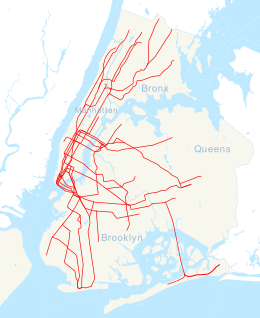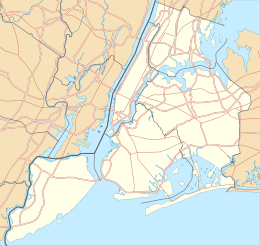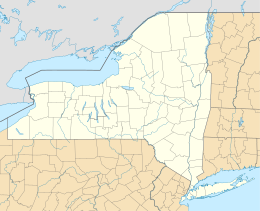railroad.wikisort.org - Station
The Grant Avenue station is a station on the IND Liberty Av Line of the New York City Subway. Located at Grant Avenue just north of Pitkin Avenue in City Line, Brooklyn, near the border between the boroughs of Brooklyn and Queens,[3][4] it is served by the A train at all times. The station is the line's easternmost stop in Brooklyn; the Fulton Street Line continues east into Queens via the Fulton Street Elevated.[4]
Grant Avenue | ||||||||||||||||||||||||||||||||||||||||||||||||||||||||||||||||||||||||||||||||||
|---|---|---|---|---|---|---|---|---|---|---|---|---|---|---|---|---|---|---|---|---|---|---|---|---|---|---|---|---|---|---|---|---|---|---|---|---|---|---|---|---|---|---|---|---|---|---|---|---|---|---|---|---|---|---|---|---|---|---|---|---|---|---|---|---|---|---|---|---|---|---|---|---|---|---|---|---|---|---|---|---|---|---|
 Grant Avenue station in 2018 | ||||||||||||||||||||||||||||||||||||||||||||||||||||||||||||||||||||||||||||||||||
| Station statistics | ||||||||||||||||||||||||||||||||||||||||||||||||||||||||||||||||||||||||||||||||||
| Address | Grant Avenue & Pitkin Avenue Brooklyn, NY 11208 | |||||||||||||||||||||||||||||||||||||||||||||||||||||||||||||||||||||||||||||||||
| Borough | Brooklyn | |||||||||||||||||||||||||||||||||||||||||||||||||||||||||||||||||||||||||||||||||
| Locale | City Line | |||||||||||||||||||||||||||||||||||||||||||||||||||||||||||||||||||||||||||||||||
| Coordinates | 40.676635°N 73.86559°W | |||||||||||||||||||||||||||||||||||||||||||||||||||||||||||||||||||||||||||||||||
| Division | B (IND)[1] | |||||||||||||||||||||||||||||||||||||||||||||||||||||||||||||||||||||||||||||||||
| Line | IND Liberty Avenue Line | |||||||||||||||||||||||||||||||||||||||||||||||||||||||||||||||||||||||||||||||||
| Services | A | |||||||||||||||||||||||||||||||||||||||||||||||||||||||||||||||||||||||||||||||||
| Transit | ||||||||||||||||||||||||||||||||||||||||||||||||||||||||||||||||||||||||||||||||||
| Structure | Underground | |||||||||||||||||||||||||||||||||||||||||||||||||||||||||||||||||||||||||||||||||
| Platforms | 1 island platform | |||||||||||||||||||||||||||||||||||||||||||||||||||||||||||||||||||||||||||||||||
| Tracks | 2 | |||||||||||||||||||||||||||||||||||||||||||||||||||||||||||||||||||||||||||||||||
| Other information | ||||||||||||||||||||||||||||||||||||||||||||||||||||||||||||||||||||||||||||||||||
| Opened | April 29, 1956 | |||||||||||||||||||||||||||||||||||||||||||||||||||||||||||||||||||||||||||||||||
| Opposite- direction transfer | Yes | |||||||||||||||||||||||||||||||||||||||||||||||||||||||||||||||||||||||||||||||||
| Traffic | ||||||||||||||||||||||||||||||||||||||||||||||||||||||||||||||||||||||||||||||||||
| 2019 | 1,749,932[2] | |||||||||||||||||||||||||||||||||||||||||||||||||||||||||||||||||||||||||||||||||
| Rank | 266 out of 424[2] | |||||||||||||||||||||||||||||||||||||||||||||||||||||||||||||||||||||||||||||||||
| ||||||||||||||||||||||||||||||||||||||||||||||||||||||||||||||||||||||||||||||||||
| ||||||||||||||||||||||||||||||||||||||||||||||||||||||||||||||||||||||||||||||||||
| ||||||||||||||||||||||||||||||||||||||||||||||||||||||||||||||||||||||||||||||||||
| ||||||||||||||||||||||||||||||||||||||||||||||||||||||||||||||||||||||||||||||||||
| ||||||||||||||||||||||||||||||||||||||||||||||||||||||||||||||||||||||||||||||||||
The funds to construct the Fulton Street Line east of Broadway Junction, including the Grant Avenue station, were allocated in 1939. Construction of the extension was delayed due to material shortages from World War II. The Fulton Street Line between Broadway Junction and Euclid Avenue opened in 1948. Funding to construct the Grant Avenue station was allocated in 1950, and the station opened in 1956.
History
Original plan
Grant Avenue was built as part of the extension of the IND Fulton Street Line east of Broadway–East New York.[5] Funding for the station was allocated in the New York City Board of Transportation's 1939 Capital Budget, projected to be completed by 1942.[6] In October 1940, construction began on the portion of the extension along Pitkin Avenue between Crystal Street and Grant Avenue. This included a station at Euclid Avenue and the Pitkin Yard, but did not include a station at Grant Avenue.[7][8] By this time, the Board acquired private property on the east side of Grant Avenue for subway construction.[9] By 1941, the intersection of Pitkin and Grant Avenues was excavated for subway construction.[10] The opening of the East New York station, and completion of all stations east to Euclid Avenue that were then-under construction,[7][11] was halted in 1942 due to supply shortages from World War II.[7][12][13]
The extension of the line to Euclid Avenue opened in November 1948, six years late.[14][15] As part of the extension, the Fulton Line tunnel under Pitkin Avenue was built up to Eldert Lane just past Grant Avenue to facilitate a future subway extension via Pitkin Avenue.[16]: 143 [17][18][19]
Modified plans
By 1947, the plans were modified so the IND line would instead use the nearby BMT Fulton Street Elevated along Liberty Avenue.[20][21] Additional trackways were installed in the tunnel just east of Euclid Avenue for a potential connection to the Fulton Street El.[22][23] The yet-to-be-built Grant Avenue station was also displayed on the signal board in the Euclid Avenue station.[22][24] In 1949, the Board of Transportation approved a plan to extend the IND Fulton Line along the eastern Fulton El to Lefferts Boulevard. The station was expected to be completed in 1952.[25] Under the original plans, the Grant Avenue station of the BMT elevated would have been preserved as the first station east of the link.[16]: 143 [26][27][28] In 1950, the New York City Planning Commission approved funding for an extension of the IND Fulton Line east from Euclid Avenue to Grant Avenue.[29][30]
In late 1952, the Board of Transportation began construction on a connection between the IND and both the Fulton Elevated and the Rockaway Beach Branch of the Long Island Rail Road, which included a new underground Grant Avenue station.[31][32][33][34] The station opened on April 29, 1956, along with the connection to the Fulton Elevated east to Lefferts Boulevard. One month later, service to the Rockaways commenced via the old Rockaway Beach Branch, which had been converted to the IND Rockaway Line.[3][7][35][36][37] The station also replaced the former Grant Avenue station on the Fulton Elevated, which was closed and demolished.[3]
Station layout
| G | Street level | Exit/entrance, station house, fare control, station agent |
| P Platform level |
Westbound | ← ← |
| Island platform | ||
| Eastbound | | |
| Yard Tracks | Yard track | No passenger service |
| Yard track | No passenger service | |

This station has two tracks and one island platform.[18] The column and wall tiles are textured light green, with "GRANT" in dark green letters going down vertically on columns and horizontally along the wall underneath the tile band; the tile band is set in a soldier course of dark green bordered by the same light green as the rest of the wall, albeit minus the textured surface.[3][38] When it opened, the Grant Avenue station featured fluorescent lighting, instead of the incandescent lights that were standard throughout the New York City Subway at the time.[3]
East of the station (or south, in terms of railroad directions), the line gains a center track from Pitkin Yard, leaves the subway tunnel and ramps up to the elevated tracks along Liberty Avenue. Once it exits the tunnel, the line enters Queens.[3][18] At the tunnel portal, another track from Pitkin Yard merges with the southbound local track. The line continues as three tracks, towards 80th Street station on Liberty Avenue. The two yard tracks are located under the station.[18]
Exit
The station's only entrance is a 1950s-style brick station-house at street level, located at the northwest corner of Pitkin and Grant Avenues.[4] Inside, there is a token booth, turnstile bank, fluorescent lights, newsstand, and three staircases to the platform.[3][39] The entrance is located next to a NYCDOT park and ride facility, signed as "Municipal Parking: Grant Avenue," that encompasses both sides of Grant Avenue.[40] Additional parking was formerly present on then-NYCT property across North Conduit Avenue, which has since been developed.[41]
References
- "Glossary". Second Avenue Subway Supplemental Draft Environmental Impact Statement (SDEIS) (PDF). Vol. 1. Metropolitan Transportation Authority. March 4, 2003. pp. 1–2. Archived from the original (PDF) on February 26, 2021. Retrieved January 1, 2021.
- "Facts and Figures: Annual Subway Ridership 2014–2019". Metropolitan Transportation Authority. 2020. Retrieved May 26, 2020.
- "First Leg of Rockaways Transit Opened at Cost of $10,154,702" (PDF). The New York Times. April 30, 1956. ISSN 0362-4331. Retrieved June 29, 2015.
- "Grant Avenue Neighborhood Map". mta.info. Metropolitan Transportation Authority. 2018. Retrieved July 7, 2020.
- Duffus, R.L. (September 22, 1929). "Our Great Subway Network Spreads Wider; New Plans of Board of Transportation Involve the Building of More Than One Hundred Miles of Additional Rapid Transit Routes for New York" (PDF). The New York Times. ISSN 0362-4331. Retrieved August 19, 2015.
- "Mr. FIXIT Reports: Fulton Street Subway". Long Island Daily Press. Fultonhistory.com. March 7, 1939. p. 10. Retrieved August 15, 2016.
- Linder, Bernard (February 2006). "Fulton Street Subway". New York Division Bulletin. Electric Railroader's Association. 49 (2): 2. Retrieved August 27, 2016.
- "Subway Contract Given to Boro Firm". The Brooklyn Daily Eagle. September 12, 1940. p. 2. Retrieved August 27, 2016 – via Newspapers.com.
- "Mr. FIXIT Reports: Subway Extension and Condemnation". Long Island Daily Press. Fultonhistory.com. December 1940. p. 12. Retrieved August 15, 2016.
- "Pitkin Avenue Decking at Grant Avenue Facing West: IND Fulton Line". New York City Board of Transportation. December 9, 1941. Retrieved August 25, 2016.
- "Letters To the Editor: A Question In Transit". Long Island Daily Press. Fultonhistory.com. October 20, 1941. p. 14. Retrieved August 15, 2016.
- Blauvelt, Paul (June 9, 1946). "Shortages Snarl $50,000,000 Tube Links". The Brooklyn Daily Eagle. p. 21. Retrieved October 9, 2015 – via Newspapers.com.
- "Priorities May Halt Work on Fulton Tube: Vital Defense Materials Are Needed To Complete Spur to Queens County Line". The Brooklyn Daily Eagle. November 18, 1941. p. 3. Retrieved August 26, 2016 – via Newspapers.com.
- "Trains Roll on $47,000,000 Fulton St. Subway Extension". The Brooklyn Daily Eagle. November 29, 1948. p. 2. Retrieved October 9, 2015 – via Newspapers.com.
- "Fulton Subway Stations Open After All-Night 'Dry Runs'". The Brooklyn Daily Eagle. November 28, 1948. Retrieved October 9, 2015 – via Newspapers.com.
- Raskin, Joseph B. (2013). The Routes Not Taken: A Trip Through New York City's Unbuilt Subway System. New York, New York: Fordham University Press. doi:10.5422/fordham/9780823253692.001.0001. ISBN 978-0-82325-369-2.
- Kennedy, Randy (January 21, 2003). "Tunnel Vision; Next Stop, 'Twilight Zone' (a k a 76th St. Station)". The New York Times. ISSN 0362-4331. Retrieved April 17, 2014.
- Marrero, Robert (January 1, 2017). "472 Stations, 850 Miles" (PDF). B24 Blog, via Dropbox. Retrieved April 27, 2018.
- "Complete Text of TA's Queens Subway Plan". Long Island Star-Journal. Fultonhistory.com. April 1, 1963. p. 8. Retrieved April 27, 2016.
- Crowell, Paul (December 15, 1947). "Subway Expansion to Cost $400,000,000 Proposed for City". The New York Times. ISSN 0362-4331. Retrieved March 17, 2021.
{{cite news}}: CS1 maint: url-status (link) - McConnell, David (December 15, 1947). "2d Av.Subway Plan Unifies B. M. T.? IND: 400-Million Line Would Take 7 Years to Build After State Referendum Removes 3d Av. 'EI' Up to 149th Street 6-Track Artery to Ease Bottleneck of Queens Trains Into Manhattan". New York Herald Tribune. p. 1. ProQuest 1318095353. Retrieved March 17, 2021 – via ProQuest.
{{cite news}}: CS1 maint: url-status (link) - "Signaling and Interlocking On New Line of New York Subways". Railway Signaling and Communications. Simmons-Boardman Publishing Corporation.: 578–583 September 1949. Retrieved December 27, 2016.
- "Crossover, Pitkin Avenue between Autumn and Lincoln Avenues: IND Fulton Line". New York City Board of Transportation. May 15, 1942. Retrieved August 26, 2016.
- "Interlocking Machine, Euclid Ave Station, "A" Line". nycsubway.org. November 23, 1948. Retrieved December 27, 2016.
- Report for the three and one-half years ending June 30, 1949. New York City Board of Transportation. 1949. p. 68. hdl:2027/mdp.39015023094926.
- Noonan, Dan (November 18, 1949). "Fulton St. Subway to Lefferts Ave. Assured in Ramp OK: $7,000,000 Link Is Approved by Estimate Board". The Brooklyn Daily Eagle. p. 3. Retrieved August 26, 2016 – via Newspapers.com.
- Bennett, Charles G. (November 20, 1949). "Transit Platforms on Lines in Queens to be Lengthened" (PDF). The New York Times. ISSN 0362-4331. Retrieved July 16, 2016.
- "Subway Expansion" (PDF). The New York Times. November 28, 1949. ISSN 0362-4331. Retrieved August 26, 2016.
- "Many Important Brooklyn Projects O.K.'d by City Planning Board". Brooklyn Eagle. Fultonhistory.com. November 6, 1950. p. 18. Retrieved August 15, 2016.
- Ingalls, Leonard (June 10, 1950). "City Plans Link Of Transit Lines For Rockaways: Work to Start This Year on Joining IND and 'El' in Brooklyn as a First Step". New York Herald Tribune. p. 2. ProQuest 1326832601. Retrieved March 17, 2021 – via ProQuest.
{{cite news}}: CS1 maint: url-status (link) - "Cashmore Hails Slum Clearance in Downtown Section". Brooklyn Eagle. Fultonhistory.com. October 16, 1952. p. 10. Retrieved August 15, 2016.
- Noonan, Dan (August 13, 1954). "Asks Funds for New Boro Criminal Courts Building: Plan To Construct It at Smith and Atlantic". Brooklyn Eagle. Fultonhistory.com. Retrieved August 15, 2016.
- "$7,000,000 Signal Job To Be Let In February: City Approves $1,000,000 Contracts For Station And Sub-Station in Broad Channel And For The Rehabilitation Of The Liberty Avenue Line". Wave of Long Island. Fultonhistory.com. December 23, 1954. p. 1. Retrieved July 22, 2016.
- "$7,000,000 Signal Job To Be Let In February: City Approves $1,000,000 Contracts For Station And Sub-Station in Broad Channel And For The Rehabilitation Of The Liberty Avenue Line" (PDF). Wave of Long Island. Fultonhistory.com. December 23, 1954. p. 7. Retrieved July 22, 2016.
- Freeman, Ira Henry (June 28, 1956). "Rockaway Trains to Operate Today" (PDF). The New York Times. ISSN 0362-4331. Retrieved June 29, 2015.
{{cite news}}: CS1 maint: url-status (link) - "New Subway Unit Ready: Far Rockaway IND Terminal Will Be Opened Today" (PDF). The New York Times. January 16, 1958. ISSN 0362-4331. Retrieved June 29, 2015.
- "Rapid Transit Link Opens In Brooklyn". Wave of Long Island. Fultonhistory.com. May 3, 1956. p. 3. Retrieved August 15, 2016.
- Chatreau, Bernard (September 25, 2011). Image 145693. Retrieved January 22, 2018.
- "Architectural Rendering of Grant Avenue Control Building: IND Fulton Line". New York City Transit Authority. August 11, 1954. Retrieved August 25, 2016.
- "Municipal Parking Facilities". nyc.gov. New York City Department of Transportation. Retrieved January 21, 2018.
- "35 Idle City Areas To Be Parking Lots" (PDF). The New York Times. November 20, 1953. ISSN 0362-4331. Retrieved June 29, 2015.
External links
- nycsubway.org – IND Fulton: Grant Avenue
- The Subway Nut — Grant Avenue Pictures
- Grant Avenue entrance from Google Maps Street View
- Platform from Google Maps Street View
Другой контент может иметь иную лицензию. Перед использованием материалов сайта WikiSort.org внимательно изучите правила лицензирования конкретных элементов наполнения сайта.
WikiSort.org - проект по пересортировке и дополнению контента Википедии




